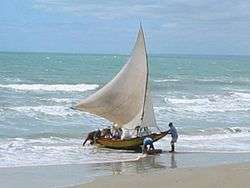Smack (ship)
A smack was a traditional fishing boat used off the coast of Britain and the Atlantic coast of America for most of the 19th century and, in small numbers, up to the Second World War. Many larger smacks were originally cutter-rigged sailing boats until about 1865, when smacks had become so large that cutter main booms were unhandy. The smaller smacks retain the gaff cutter rig. The larger smacks were lengthened and re-rigged and new ketch-rigged smacks were built, but boats varied from port to port. Some boats had a topsail on the mizzen mast, while others had a bowsprit carrying a jib.
Large numbers smacks operated in fleets from ports in the UK such as Brixham, Grimsby and Lowestoft as well as at locations along the Thames Estuary. In England the sails were white cotton until a proofing coat was applied, usually after the sail was a few years old. This gave the sails its distinctive red ochre colour, which made them a picturesque sight in large numbers.[1] Smacks were often rebuilt into steam boats in the 1950s.
Military use
Smacks were used in British coastal waters during World War I as Q ships. Actions involving smacks include the Action of 15 August 1917, when the armed smacks Nelson and Ethel & Millie engaged a German U-boat in the North Sea. During this action the Nelson was sunk and its skipper, Thomas Crisp, was posthumously awarded the Victoria Cross. Another Lowestoft smack, HM Armed Smack Inverlyon, commanded by Ernest Jehan, sank the German U-boat UB-4 earlier in the war, the only example of a wooden sailing vessel sinking a modern steel submarine.
Modern use
Some old smacks have been re-rigged into ketches and are now used as training boats for young sailors. Other smacks are preserved in museums or used as floating museums.
The Excelsior is an example of a preserved smack. Built in Lowestoft in 1921, she is a member of the National Historic Fleet and operates as a sail training vessel.[2] Boadicea is an example of a well-preserved smaller smack. She was built in Maldon, Essex in 1808.[3]
References
- ↑ March, E J (1970) Sailing trawlers;: The story of deep-sea fishing with long line and trawl. David & Charles. ISBN 978-0-87742-004-0
- ↑ Excelsior: History, National Historic Ships Registry. Retrieved 2011-04-21.
- ↑ "Boat reaches its 200th birthday". BBC News. 17 June 2008. Retrieved 31 October 2012.



